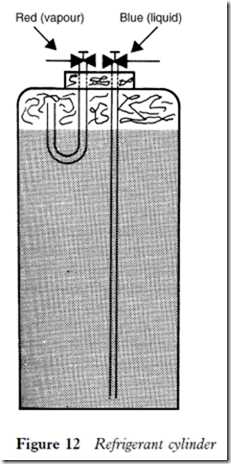Refrigerant cylinders and fill ratio
Refrigerant bulk cylinders and some service cylinders are fitted with two shut- off valves, which are colour coded and marked to indicate delivery of either liquid or vapour.
Two tubes supply refrigerant to the valves (Figure 12). One terminates at the top of the cylinder above the liquid level, and when the vapour valve (red) is opened it will discharge vapour only. The other tube from the liquid valve
(blue) terminates almost at the bottom of the cylinder, and when the valve is opened it will discharge liquid until the cylinder is virtually empty.
Modern cylinders have capacities, maximum fill quantity and identification of the contents stamped on the cylinder. Older types may only have the total weight and the tare (empty cylinder weight). The total weight is the weight of water contained in the cylinder if it was completely full (the water capacity) plus the tare.
A refrigerant is a volatile substance, and is more responsive than water to density changes at different temperatures. For this reason a cylinder should never be completely filled with refrigerant.
A simple calculation can be made to determine the amount of refrigerant which can safely be transferred into a service cylinder. A safe fill for any refrigerant is 80 per cent of the water capacity. For example, assume the total weight of a cylinder to be 24 kg and the tare to be 4 kg. Then the water capacity is 24 – 4 D 20 kg. The maximum fill is 80 per cent of 20 kg, i.e. 16 kg.
